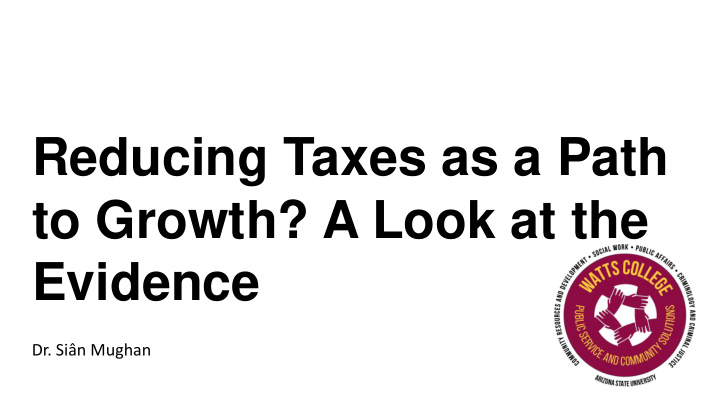



Reducing Taxes as a Path to Growth? A Look at the Evidence Dr. Siân Mughan
Key Points • House Joint Resolution 17 (2019): A constitutional amendment to exempt business inventory, machinery, and equipment from property taxation • Motivating idea: Reducing taxes on business stimulates economic growth • Existing evidence provides mixed support • Key Takeaway: Are tradeoffs involved in cutting taxes • Benefits of lowering tax burden on business are unclear • Tax cuts very rarely pay for themselves • How will tax cuts be paid for, much do we spend on public services and who should pay?
Tangible Personal Property (TPP) Tax • What is tangible personal property? Property that can be touched or moved • TPP on Business property applies to machinery & equipment and inventory (capital) • Approximately two-thirds of property taxes fund schools
What Do Other States Do? Machinery & Equipment Inventory
Arguments For and Against Taxing Business Property Against For • Reduces firm’s competitiveness • Tax policy has limited impact on: • Business activity • Reduces investment in production • Hiring/location decisions capacity • Making capital cheaper relative to • Alter business’s production, labor suggests negative investment and location decisions employment effects • Is administratively burdensome • Provides key revenues which fund (high compliance costs) key services • Businesses benefit from services provided using local tax dollars
Related Academic Literature • State corporate individual/income taxes • Evidence is mixed • Income tax reduction lead to tax avoidance and income shifting but little to no effect on economic activity (Debacker, Heim, Ramnath and Ross 2019) • “[T]he present study finds that a state’s personal tax rate has a negative effect on firm location but that a state’s corporate tax rate has no statistically significant effect on firm location (Gius and Frese 2002).” • We find the corporate income tax has a [statistically] significant negative impact on employment while the sales and individual income taxes do not (Harden and Hoyt 2003).” • Matters how tax cuts are paid for • Tax increases may benefit economy when spending on public services boosts economic outcomes (Helms 1985; Gabe and Bell 2004)
Tangible Personal Property Tax in Ohio • House Bill 66 (signed 2005) eliminates TPP tax • 3-year phase out beginning in 2006 • Prior to 2006 personal property assessed at 25% of its value • Reliance on TPP declining from 12.6% to 6.4% over 1980-2005 • Collected an average of $2.1 billion per year (≈ 16.5% of all property tax revenue) • ≈ 70% of revenues fund k -12 education • Replaced TPP with a business gross receipts tax- Commercial Activity Tax
Projections Proponents Opponents • HB 66 projected to create 43,250 • Decline in manufacturing driven by new jobs , increase economic national and global forces, output by $2.5 billion over 5 years reducing business’s tax burden (Honeck & Shiller 2005) unlikely to have a major effect on employment • HB 66 would “do more to protect • Projected to result in a net job security in Ohio than any single public policy action in the last reduction of more than $2.8 billion several decades (Ohio in Ohio tax revenue in 2010 Manufacturing Association (Honeck & Shiller 2005) Executive quoted in Hershey, 2005). “
TPP Tax in Ohio (Mughan & Propheter (2017) Find that in the short term TPP elimination reduced manufacturing employment below what it would have been if the TPP remained in place • By approximately 19,300 jobs annually Why?
Elimination of TPP Tax in Ohio • 3 inputs into production process; land, labor and capital • TPP tax elimination reduces the cost of capital (equipment and machinery) relative to labor and land • Also makes it cheaper to hold on to unproductive capital • Short run: Lower employment growth as firms invest in capital rather than hire new workers • Long run: More productive capital may improve a company’s competitiveness, boosting output which may then boost employment • What happens depends on the substitutability between labor and capital • How capital intensive is the production process and how easily can machines/equipment replace human workers?
Takeaways • Taxes place a burden on businesses (and individuals) and are one factor of many in firm production and location decisions • Empirical evidence is mixed, suggesting that the relationship between taxes and economic growth is complicated; lower taxes do not necessarily result in economic growth • Taxes also raise money communities rely on for vital public services • All else equal, cutting taxes will mean less money for those services • Tax cuts should be thought of as a tradeoff, they will obviously deliver benefits to business. The important questions are: • What will be the benefits to the wider community? • What costs will accrue to other tax-payers?
THANK YOU!
Recommend
More recommend